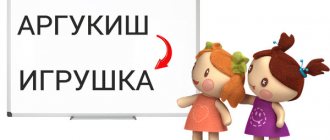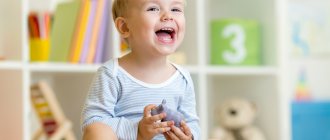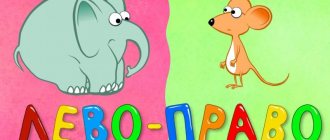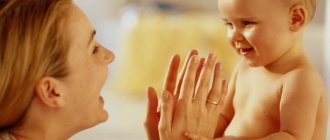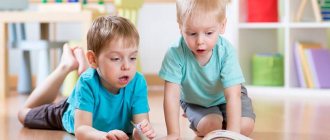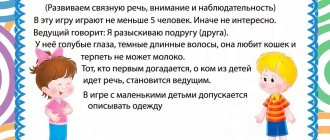Why does the speech “not work”?
Normally, by the beginning of the second year of life, the child already begins to speak in simple words and has 10-20 words in his vocabulary. By the age of three, this number increases to 3 thousand, and by school age (7 years) speech has almost reached the speech of an adult in its development. In theory, everything is simple, but in practice, parents are constantly faced with various deviations from these norms. What could be the reason? Let's look at the most common of them:
- fetal asphyxia during obstetrics;
- diseases suffered by the mother during pregnancy;
- conditions of the social environment - inattention to the development of the child’s speech, “lisping”, bilingualism in the family, a state of stress or fear.
In other words, the problem can be hidden anywhere. The good news is that the percentage of influence of various maternal diseases during the perinatal period is actually quite small, the same applies to congenital genetic diseases that interfere with the development of speech. So most of the speech therapy questions and tasks arise as a result of the social factor. This does not eliminate the need to promptly contact specialists, including medical ones, in order to completely eliminate physical problems. In general, if you have any problem or difficulty, it is better to maintain contact with relevant specialists - it is better to pay more attention and waste it than to pay less attention and then not be able to fix anything.
general characteristics
works within the framework of the “Speech Therapist Plus” project and is listed as an autonomous non-profit organization of additional professional education. This institution was created on the basis of the Moscow speech, known in the 80–90s of the last century. In its current form, the educational institution has been operating since 2008 and has a valid license for educational activities.
The center's teachers help speech therapists from many Russian cities improve their skills. The training is conducted using patented proprietary methods, so students receive first-hand expert advice. Every year the institution holds more than 200 events designed for large audiences.
“Speech therapist master” works not only with specialists who want to gain experience. Some seminars and master classes are intended for parents of children with speech impairments, and the information in such classes is presented in a form accessible to the widest range of listeners. Again, for parents, the center’s staff created a series of educational films, “Mom’s School,” which will be useful to everyone who cares about the development of their own child.
The center's teachers conduct individual correctional classes with children and adults, successfully treat stuttering and correct other speech disorders. If necessary, a specialist can come to your home or consult via Skype.
The organization’s website has a lot of information for self-study: methodological materials for speech therapists, articles for specialists and parents, a list of additional literature. As part of the “Speech Therapy for Dummies” project, all visitors to the site have access to a complex of articulatory gymnastics - universal exercises for the lips and tongue that a child can perform at home under the guidance of adults.
What to do?
When parents notice something that does not correspond to the norms, they begin to intensively look for a solution to the problem, some evidence of a violation or, conversely, evidence of the correct order of things. This is how the first meeting takes place with a speech therapist, who is approached with the question of how to improve the child’s speech. There may be several violations:
- incorrect pronunciation of sounds;
- “swallowing” part of a word;
- incorrect construction of words and phrases (rearrangement of sounds and syllables);
- the impossibility of meaningful transmission of information through speech.
These are the most common difficulties that children have when developing speech, and an experienced specialist will make every effort to correct the situation. But we should not forget that the participation of parents is very important in everything that happens to the child - neither the child nor the speech therapist can cope without their help.
What is the role of parents in this process? She's colossal. It is on the speech of the adults who surround the baby that his ability to assimilate information and the possibility of competently delivered and coherent speech depend. What can parents do?
- Clearly and distinctly pronounce one’s own actions, surrounding objects, etc.;
- Gently but constantly correct the child’s mistakes;
- Conduct playful activities with your child, teaching correct speech;
- Minimize stress, fear and negative feelings.
But these are the most basic, “external” factors. The structure of home activities and their methods play no less role. Let's take a closer look.
Features of home activities
As you know, this development directly depends on the forces exerted by parents on the development of the child. However, as in any other matter, it is very important not to overdo it, and for this it is important to remember about the age norms of development and the relationships in it.
So, 1 year - the child begins to speak. It is very important at this moment to replace the simple “bibika”, “yum-yum” and so on with adult words - “car”, “food”, etc. At this age, children very quickly absorb surrounding information, and even if speech is still far away from articulateness and intelligibility, then all words and word forms pronounced by others are firmly deposited in the brain.
By the age of 3, a child’s vocabulary increases, as does his speech capabilities. You can use more complex structures; it is extremely important to monitor the purity of your own speech. At this age, you can begin classes for better development - learning letters, making sounds. Exercises from articulatory gymnastics and finger games are well suited for these purposes (the development of fine motor skills has a positive effect on the development of the brain, which also has a good effect on the development of speech).
With regular lessons, by the age of 6, the child will have an impressive vocabulary, well-spoken speech and the ability to express complex structures.
An important feature is that at the age of 3 there is a developmental crisis of “I myself”, and it is very important to interest the child in activities. In addition, the classes themselves should be held in a fun way - in the form of stories, adventures, fairy tales, and the child’s involvement in them should be significant. At the same time, an adult must demonstrate by his own example an interest in what is happening; children more often agree to do something together with adults, rather than alone.
One more nuance - in no case should you make developmental activities look like a school with its lessons. Small children are physically unable to concentrate their attention for more than 5 minutes on the same object, even if they really need to. Try to select moments when the baby is most calm and ready to receive. Try not to put pressure or force - the best option would be if the child himself offers to work out. Do not reject his desires - this way you will form a useful habit and maintain interest in these actions.
But here the question arises: what kind of literature should be used to develop speech and present it correctly?
Methodological literature for speech therapist teachers
Diagnostic material
Inshakova O.B. Album for a speech therapist. — M.: Humanite. ed. VLADOS center, 1998.
The album provides illustrated material for examining the oral speech of children of senior preschool and primary school age, which allows us to identify violations: sound pronunciation, syllabic structure of words, phonemic analysis and synthesis, vocabulary and grammatical structure of speech.
Visual material for examining children. Appendix to the methodological manual “Psychological and pedagogical diagnostics of the development of children of early and preschool age” / ed. E.A. Strebeleva - Moscow, “Enlightenment”, 2007.
The appendix provides specific material for a comprehensive psychological and pedagogical examination of children of early and preschool age (4 sets).
Psychological and pedagogical diagnostics of the development of children of early and preschool age : method. manual / ed. E.A. Strebeleva - M.: Education, 2007.
The manual was created on the basis of a modern approach to diagnosing the mental development of children of early and preschool age. Includes a description of methods aimed at identifying the level of cognitive and speech development, and examining the hearing of children of different age categories.
Program material
“From birth to school. Approximate basic general education program for preschool education” / Ed. NOT. Veraksa, T.S. Komarova, M.A. Vasilyeva . - M.: MOSAIC-SYNTHESIS, 2010.
The program was developed in accordance with the current Federal state requirements for the structure of the basic general education program of preschool education (FGT, Order No. 655 of November 23, 2009). The goal of the program is the comprehensive development of mental and physical qualities of children from birth to 7 years old in accordance with their age and individual characteristics.
Filicheva T.B., Chirkina G.V. " Education and training of preschool children with phonetic-phonemic speech underdevelopment." Program and methodological recommendations for a compensatory preschool educational institution (senior group). - M.: School Press, 2003 .
Children with phonetic-phonemic speech underdevelopment are the most common category of children with speech development disorders. they represent a real group for poor performance in mastering writing and reading in a general education school.
Filicheva T.B., Tumanova T.V. Children with phonetic-phonemic underdevelopment. Education and training. Educational and methodological manual for speech therapists and educators. - M.: “Gnome-Press”, 1999.
The presented material contains a description of the characteristics of the speech development of five-year-old children with functional disabilities, methodological techniques for examining them, and reveals issues of the organization and content of remedial education to overcome phonetic-phonemic underdevelopment in children.
Methodological material
Gomzyak O.S. We speak correctly. Notes of frontal lessons of I - III periods of study in the preparatory group for school . - M.: Publishing house GNOM and D, 2007.
The manual includes a long-term plan and lesson notes. Each lesson is comprehensive, based on one lexical topic and contains exercises selected according to the degree of increasing complexity for the development of general, articulatory and fine motor skills, speech breathing, voice, pronunciation and teaching children literacy and coherent speech (3 books).
Borisova E.A.
Publisher: Sfera, 2011
Series: Library of the magazine "Speech therapist"
“Individual speech therapy sessions with preschoolers. Toolkit"
The manual covers the structure, content and forms of individual lessons with preschoolers who have general speech underdevelopment. Much attention is paid to formulating the topic and goals of the lessons, their phasing, the use of varied and colorful visual material, creating a positive emotional background and gradually increasing the complexity of the material presented. An entertaining form of classes, game techniques, changing types of tasks, and a reward system will help keep children’s attention throughout the entire lesson and generate interest in continuing to work with a speech therapist. The manual is addressed to speech therapists and teachers of speech therapy groups at preschool educational institutions.
Articulation of sounds in a graphic image. Educational and demonstration material. Appendix to the book by E.V. Novikova “Speech therapy alphabet. A new method of teaching reading." M.: Publishing house GNOM and D, 2006. We present to your attention 45 diagrams that show the position of the articulatory apparatus during the pronunciation of vowels and consonants.
Skvortsova I.V. Development and training program for preschoolers. 100 speech therapy games. For children 4-6 years old. - St. Petersburg: Publishing House “Neva”; M.: "OLMA-PRESS Education", 2003.
This book contains games and tasks that help eliminate gaps in the development of grammatical structure of speech, enrich a child’s vocabulary, develop interest in words, and serve as a good basis for successful learning at school. In parallel with the development of speech, the child’s memory and attention are trained, he learns to think, draw conclusions, analyze and fantasize.
Komarova L. A. “Automation of sound in game exercises. Album of a preschooler." 10 pieces. M.: Publishing house. GNOM and D, 2009 The manual proposes a system of exercises for automating sounds for preschoolers 4-7 years old, which turns the monotonous and monotonous work of consolidating the pronunciation of sounds into an interesting game. Along with its automation, the child’s reading skills improve, fine motor skills and creative imagination develop. Automation of sounds is carried out according to the traditional scheme in speech therapy. The effectiveness of correctional work is ensured by the use of a number of auxiliary techniques (working with three-dimensional and flat toys, counting sticks, creating game situations in class).
Zhikhareva-Norkina Yu.B. Home notebook for speech therapy sessions with children: a manual for speech therapists and parents: 9 albums - M.: Gumanitar, ed. VLADOS center, 2005
The manual contains entertaining game tasks for children of preschool and primary school age, which contribute to the formation of correct sound pronunciation, enrichment of vocabulary, and development of graphic skills.
Spivak E.N.: Speech material for automation and differentiation of sounds in children 5-7 years old.
M.: Gnom i D, 2007 This manual offers practical material on the automation and differentiation of whistling sounds, hissing sounds, and sonors in children of senior preschool age with speech disorders. The material in the manual was selected taking into account the pronunciation capabilities of children, is filled as much as possible with automated sounds and is arranged in order of complexity (“from simple to complex”).
Osmanova G. A., Peregudova T. S.
Ed. Karo, 2010
“We introduce sounds into speech. Card file of tasks for automating the sounds S, Z, Ts, Sh, Zh, Ch, Shch, L, L, R, R'
The manual is a system of cards with tasks for automating sounds in children's speech. It can also be used in the development of phonemic hearing in preschoolers, helping to clarify and expand their vocabulary. The material is traditionally divided depending on the position of the automated sound in the word, provides for the complexity of the syllabic structure of words, as well as the presence of those sounds that children do not cause difficulties in pronunciation. The book contains cards with pictures that can be used to automate sounds in independent speech. The sounds in the names of the pictures are in different positions at the beginning of the word, at the end, in the intervocalic position, in words with a combination of consonants. Attentive parents can use the material in the manual to reinforce their child’s correct sound pronunciation at home, during the holidays, during vacations, developing his speech, cultivating a love for his native language and a culture of verbal communication.
Author: Kulikovskaya Tatyana Anatolyevna
Publisher: Gnome, 2012
“Speech therapy tongue twisters and counting rhymes. Speech material for automating sounds in children"
This manual is intended for automating difficult consonant sounds S, Сь, 3, Зь, Ц, Ш, Ж, Шч, Ш, Л, Ль, Р, Рь in children and adults with speech disorders. The manual consists of three parts. In the first part of the manual, it is proposed to practice correct pronunciation by repeating the author's pure sayings. In the second part, children are offered speech therapy rhymes to repeat and memorize. The third part presents the author's tongue twisters. They are written in a humorous manner, so they are easy to understand and remember.
Bezrukova O.A. Grammar of Russian speech.
Set of 2 books
Ed. Russian speech
The book “Grammar of Russian Speech” is intended for conducting individual lessons on the development of Russian speech in children of preschool and primary school age. With the help of specially selected, colorfully illustrated tasks, the child develops holistic, systematic ideas about Russian grammar. The contents of the book are based on modern scientific research in the field of children's speech. Recommended for speech therapists, educators, parents and all those who are concerned about the problem of speech development in children. The book is also useful for those who study Russian as a foreign language.
Bezrukova O.A. Russian language in illustrations for preschoolers (methodological manual + illustrative material).
Publisher: Russian Rech, 2009
This scientific and methodological manual was published as part of the educational project “Science of Russian Speech” in the “Science to Practice” series. The educational and methodological manual “Russian language in illustrations for preschoolers” is intended for conducting frontal classes in the Russian language and the development (correction) of speech of preschool children. The manual includes specially selected large-format illustrative material that promotes language acquisition on a systematic basis, and a collection of lexical and grammatical tasks developed by the authors of the methodology. For speech therapists, preschool teachers and teachers of Russian as a foreign language.
Author: Ivanova Yulia Vladimirovna
Publisher: Gnome, 2011
“Preschool speech center. Documentation, planning and organization of work"
This manual contains practical materials on organizing work at a preschool speech center: regulatory documents, plans, samples of reports on the work done during the school year, samples of organizational documents regulating the work of a speech therapist with teachers and parents, and documents necessary for conducting an examination. The manual also contains notes from introductory classes—speech training—in which the speech therapist prepares the articulatory apparatus and fine motor skills of children for subsequent correctional work. The manual is addressed to speech therapists working at speech centers in preschool educational institutions.
Bezrukova O.A. Words of the native language.
Publisher: Russian Rech, 2008
The linguistic material of the book “Words of the Native Language” is based on a systematic approach to the formation of the lexical sphere of a child’s language. The sections are arranged in a certain sequence; the proposed material covers the most important information about the vocabulary of the native language for preschool age. The materials in the book can be creatively used by teachers or parents, subject to the general scheme of work proposed by the author.
Ivanovskaya O. G., Gadasina L. Ya.
Publisher: Karo, 2007
"Encyclopedia of speech therapy games"
The book is about how fingers, being from birth not only the child’s main assistants, but also his first toys and counting sticks, contribute to the development of thinking and speech. Pedagogical imagination in games, riddles, proverbs, sayings, tongue twisters, pestushki, nursery rhymes, counting rhymes, jokes, round dances, poems. A reference book for children entering school, their parents, teachers, educators and speech therapists.
Fomicheva M.F. Moscow “Enlightenment”, 1989. This manual contains types of speech disorders, methods of their correction (step by step for each age group, brief characteristics of children’s speech), as well as many speech games and speech material.
Volkova L. S.
Publisher: Vlados, 2009
“Speech therapy: A textbook for students of defectology faculties of higher pedagogical institutions. textbook establishments"
Approved by the Ministry of Education and Science of the Russian Federation as a textbook for students of defectology departments of pedagogical higher educational institutions. The textbook discusses methodological, theoretical and practical aspects of speech therapy, as well as issues of organizing speech therapy work. Traditional approaches and modern new technologies in the methodology of speech therapy work are described, the achievements of domestic and foreign theory and practice of speech therapy are outlined. The book presents a conceptual, categorical and terminological dictionary.
Shchetinin Mikhail
Publisher: Metafora, 2011
“Breathing gymnastics A.N. Strelnikova"
The phenomenon of the so-called paradoxical breathing exercises of A. N. Strelnikova is known far beyond the borders of our country. Her results are truly amazing. With the help of several simple breathing exercises performed while compressing the chest while inhaling, it was possible to stop an attack of suffocation due to bronchial asthma, get rid of chronic bronchitis and sinusitis, overcome stuttering, and regain a lost voice.
Speech development. "Learning to speak correctly."
When you launch the program, you are taken to the main screen, which includes four main sections: non-speech sounds; onomatopoeia; speech sounds; development of coherent speech. Each section includes a set of interactive tasks that require a mouse and speakers (or headphones).
Tkachenko T.A. Fine motor skills. Gymnastics for fingers. — M.: Eksmo, 2005. The author presents a system of 44 entertaining exercises for the development of finger motor skills in preschoolers and primary schoolchildren. Regular practice with this book will help give your child's finger movements strength, accuracy and consistency.
Kulikovskaya T.A. "Articulation alphabet". - M.: Publishing House "Karapuz", 2004. The book contains a large number of articulation exercises. They serve for various purposes: to strengthen and stretch muscles, to be able to relax muscles, to develop correct speech exhalation and directed air flow. All exercises are necessary for your child and will be of great benefit for the formation of the sound side of speech.
Didactic material
Konovalenko V.V., Konovalenko S.V. Polysemy of verbs in Russian: 48 color cards. - M.: Publishing house GNOM and D, 2008.
The polysemy of 24 verbs (selected with 2 meanings each) for preschool children is presented visually for the first time, in pictures. The material is intended for both individual work and for classes with a group of children.
Grammar in pictures." - M.: Publishing house. Mosaic-Synthesis, 2005. A series of visual and didactic aids are intended for group and individual lessons with children aged 3-7 years in kindergarten and at home. Topics: “Antonyms. Adjectives", "Antonyms. Verbs”, “Polysemous words”, “Word formation”, “Speak correctly”, “Plural”, “One-many”, “Stress”. The manuals are recommended for use in classes on the development of speech and thinking.
Demonstration material for frontal exercises. Sets of pictures on all lexical topics (24 pieces). - M.: Publishing house "Knigolyub" LLC, 2000.
Konovalenko V.V. Cardinal numbers 1, 4, 5 + nouns. Didactic game for children 5-7 years old. - M.: Publishing house "GNOM and D", 2006. This game will help children overcome difficulties in mastering the grammatical structure of the Russian language. Aimed at the practical assimilation and consolidation in a playful form of skills in the formation and use of nouns in the form of the genitive plural in speech.
“Call it in one word.” — Kirov, “Rainbow”, 2002. Developmental tasks are intended for children from the age of five. They will help develop the child’s logical thinking, which is important in the fall when entering school.
Educational and gaming kit, Kirov, JSC "Raduga" 2012. Series "Educational games" - Couples. All lexical topics. In Russian and English. Games for developing attention, memory, speech and imagination. “Couples” are two identical pictures. Each themed edition of this game contains 24 couples with beautiful images of flowers and trees, birds and animals, insects and fish. Getting to know them is mandatory for every preschooler.
Find differences. 4-5 years" Zemtsova O. N.
Publisher: Makhaon, 2012
The author has prepared a series of “Smart Books”, each of which provides tasks in a playful form for the development of certain skills, taking into account the age of the child. By studying with this book, kids will develop visual perception and voluntary attention. For children 4-5 years old. Artists A. Armatynskaya, I. Doroshenko.
Tkachenko T. A.
Publisher: Knigolyub, 2007
“Phonemic perception: Formation and development. Speech therapy notebook"
It is designed for joint work between an adult and a child. The “Speech Therapy Notebook” contains entertaining and colorful material with a correctional and developmental focus. Addressed to speech therapists, educators and parents for correctional work with children 4-6 years old who have different levels of speech development: from babbling speech and an almost zero threshold of phonemic perception to speech with elements of phonetic-phonemic underdevelopment. Can be used in group and individual forms of training.
Game library of speech games: Issue 1-12: For children 5-7 years old with speech disorders Bikina N.V. Melnikova S.M., - M.: Gnom i D, 2006
What are we made of? 2. Lotto game Burdin S.V. Publisher: Vesna-Design, 2006 Series: Fun in Pictures The didactic board game “What We Are Made of 2” talks about what common things are made of: balloons, ice cream, yogurt, clothes, books, rockets, dryers and bagels and much more. Purpose of the game: 1. Expanding knowledge about the world around us. 2. Expansion of vocabulary.
This game develops logical thinking, fine motor skills, observation, speech, teaches the child to build chains of associations, select images of objects and living beings by association. The set includes 10 round task cards with drawings. To each of them you need to attach 4 small answer cards with drawings that logically complement what is shown on the round card. This results in a larger square. The set includes a total of 40 answer cards, so your child will have to work hard to find the right cards for each task. It is recommended to start with one task at a time, and gradually increase the number of tasks. The educational game “Associations” can be played by 1 to 10 children at the same time. If there are many players, an element of competition will be important.
This educational game develops the child’s logical thinking, fine motor skills, observation, speech, and helps the child understand the meaning of the concepts “part” and “whole.”
The set includes 10 round task cards with a drawing of an object. You need to attach to it 4 small answer cards with drawings of the parts of this item. Thus, a larger square is obtained.
The set includes a total of 40 answer cards, so your child will have to work hard to find the right cards for each task. It is recommended to start with one task at a time, and gradually increase the number of tasks.
The educational game “Part and Whole” can be played by 1 to 10 children at the same time. If there are many players, an element of competition will be important.
Helps your baby develop attention, logic, and thinking. With this game, the child will explore the world with a smile and pleasure.
This game develops logical thinking, fine motor skills, observation, speech, and forms an idea of the “contours of an object.” The set includes 10 round task cards with images of mixed up contours. To each of them you need to attach 4 small answer cards with drawings that logically complement what is shown on the round card - objects corresponding to the contours shown on the central card. This results in a larger square. The set includes a total of 40 answer cards, so your child will have to work hard to find the right cards for each task. It is recommended to start with one task at a time, and gradually increase the number of tasks. Games in the series “Learn by playing!” cover all the material necessary for the comprehensive harmonious development of preschool children, and can be recommended for classes both in a kindergarten group and at home. The series consists of 30 original games designed to expand children's understanding of the world around them and develop their natural abilities.
Children's puppet theater has a lot of different developmental and psychological effects that are very useful for raising a child. It perfectly trains memory, helps to cope with shyness, develops speech and helps increase the baby’s interest in books. In addition, puppet theater is a very effective way to understand and often resolve a child’s internal conflicts that he himself cannot or is afraid to express.
| Lacing | |
| The game guide is aimed at developing fine motor skills of the hand, refining finger movements, concentration, and promotes the development of eye accuracy, coordination of movements and sequence of actions. It prepares the hand well for writing and trains perseverance. | |
Cones
The benefits of massage are undeniable and have been repeatedly proven in practice. Self-massage can be carried out not only individually, but also in frontal classes with a group of children at the same time, and can also be used repeatedly throughout the day, including it at various scheduled moments in a family and preschool setting. I bring to your attention a massage with spruce, cedar, and pine cones. Easy-to-memorize verses will help make the lesson fun and coordinate speech with movements.
Games with clothespins (from personal experience)
Constant stimulation of the areas of the cerebral cortex responsible for fine motor skills is a necessary element in the speech therapy system.
Today, stores have a huge selection of construction kits, puzzles, etc. Household items will bring no less benefits to the baby than special educational games. Games with household utensils are the simplest, most accessible and bring great joy to children. Such a toy can be clothespins, activities with which can be classified as a non-traditional form of work.
Price
The cost of training programs (modules) depends on their volume and form of classes. Prices for services for legal entities are 50% higher than for individuals. The center will send an invoice for payment upon request.
| Program volume, hours | Form of study | Price |
| 8 | full-time | 1500 |
| 16 | full-time | 3500 – 4000 |
| 72 | full-time | 8000 – 15000 |
| 72 | remote | 4000 – 6000 |
| 144 | remote | 8000 – 13000 |
| 216 | remote | 13000 – 13500 |
During their work, the center’s specialists made about 100 educational films, which can be purchased for a fee. The cost of one video recording is from 700 to 4000 rubles.
Types and directions of programs
The training center conducts a variety of classes designed for professional speech therapists. Various topics:
- setting a specific sound;
- stuttering treatment;
- treatment of aphasia in adults;
- correction of dysgraphia and dyslexia;
- articulation and breathing exercises;
- working with autistic and speechless children.
A complete list of programs is presented on the center's website. In the thematic rubric you can select the time of study, teacher and city. The geography of on-site courses is very extensive: from Kaliningrad to Vladivostok. A convenient schedule drawn up a year in advance allows each student to select a program on a topic that is important to him in advance.
Training
Advanced training courses attract specialists interested in professional development to the center. The programs meet modern Federal State Educational Standards requirements and are devoted to topical issues:
- technologies for overcoming articulation disorders;
- speech examination of preschool children;
- child neuropsychology;
- speech therapy work with children with motor alalia;
- correction of pronunciation in accordance with the requirements of the Federal State Educational Standard;
- violations of written speech.
The program, designed for 8, 16, 72 or 144 hours, can be completed full-time and immediately receive a certificate of completion. Students of distance courses (72, 144 or 216 hours) of training are also issued a document.
Seminars, internships, master classes
Personal communication with experienced speech therapists is irreplaceable, so the center offers various forms of classes under the guidance of teachers:
- master classes and workshops on speech therapy and probe massage;
- on-the-job internships for students and young professionals;
- family consultations.
It is proposed to study the “Wave” method of treating stuttering using the method of complete immersion: an internship in a working group is carried out with a break from work for 10–12 days.
Forms of classes and terms
Training at the center is organized in such a way that everyone, regardless of where they live, can obtain the necessary knowledge. The following forms of additional education are provided:
- Full-time. Master classes, lectures and seminars are held throughout the year. Many programs are divided into modules of 8 or 16 hours, so if you wish, you can choose only a narrow topic that interests you and devote 1 or 2 days to studying.
- Correspondence. The center offers many programs that can be completed remotely via the Internet. About 50 topics are available for study at any convenient time: materials can be ordered in the form of text or video.
In addition, “Speech therapist master” invites certified specialists for a one-day or longer (10–12 days) internship under the supervision of a candidate or doctor of pedagogical sciences.

